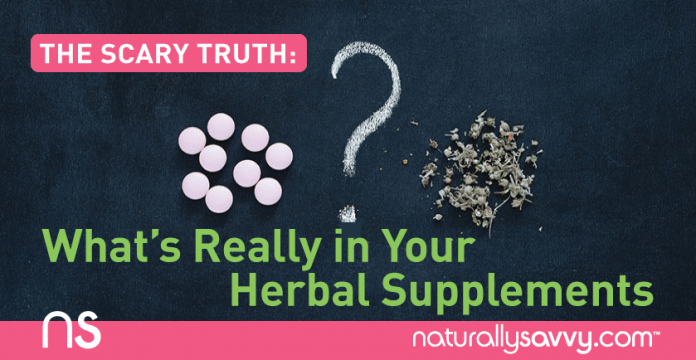
No one likes to be cheated or have their health threatened, yet that’s exactly what can happen if you take a contaminated or bogus herbal supplement. For the nearly 18 percent of the population who takes herbal supplements (non-vitamin, non-mineral dietary supplements), this is a serious concern.
Since reporting on this topic back in 2013 (“Are Your Herbal Supplements Contaminated?”), there have been other reports of herbal supplements not containing their stated ingredients. This ongoing problem highlights the need for consumers to be constantly on the alert when purchasing herbal products.
Do you know what’s really in your herbal supplements? What have recent investigations uncovered? How can you protect yourself and your family from phony herbal products?
Phony Herbal Supplements
One of the more recent reports (February 2015) comes from New York State, where the attorney general’s office reported that four major retailers-GNC, Target, Walmart, and Walgreens-were found to be selling dietary supplements that were contaminated and/or did not contain the ingredients listed. In fact, overall 80 percent of the products tested did not contain any of the herbs listed on the labels. Instead, they contained fillers (e.g., rice, house plants) or ingredients that could cause reactions in people who have food allergies.
Read more: Are Your Herbal Supplements Contaminated?
Examples of what the authorities discovered when testing store brands of herbal supplements from these retailers include:
- Five out of six samples of GNC’s Herbal Plus supplements did not contain the listed ingredients. A ginkgo biloba product, for example, consisted only of asparagus, rice, and spruce. Their St. John’s wort, Echinacea, and ginseng products had none of these ingredients in them.
- A Walmart brand of ginkgo biloba consisted of powdered radish, wheat, and house plants, even though the product label also said it was wheat- and gluten-free.
- Three of six products tested from Target’s Up and Up store brand (valerian root, St. John’s wort, and ginkgo biloba) contained none of the stated herbs and instead consisted of wild carrots, beans, powdered rice, garlic, saw palmetto, and/or peas.
- At Walgreens, its Finest Nutrition brand of gingko biloba, St. John’s wort, ginseng, garlic, and Echinacea did not contain these herbs. Instead, the main ingredient was rice, and although the garlic supplement did not contain garlic, the pungent herb was found in the ginseng and Echinacea products!
- The gingko biloba, St. John’s wort, ginseng, and Echinacea supplements of another Walmart brand, Spring Valley, were completely free of their main ingredient, and only one garlic sample showed any sign of the herb.
Contaminated Supplements
Many supplement consumers make their purchases on the Internet, and that means there’s a greater chance of buying products from other countries. In a recent report in Nutrition Journal, a team of investigators in South Africa evaluated 138 supplements from pharmacies, consumers, manufacturers, and distributors and found that 47 percent (65) of them were positive for melamine. The majority (50) of the melamine-positive products were imported into South Africa.
Although the amount of melamine in the supplements (median concentration, 6.0-8.9 ug/g) was within the Tolerable Daily Intake limit established by the World Health Organization (200 ug/g), consumers should still be aware that some supplements may contain this potentially hazardous substance. Melamine has been linked to severe health problems in infants and young children exposed to the chemical in milk products in China as well as kidney failure and death of cats, dogs, and pigs.
Read more: Are Your Vitamin Supplements More Harmful than Helpful?
Mycotoxins in Your Herbal Supplements
An investigative team evaluated 69 herbal supplement samples from both the Czech and US marketplace and found that nearly all of them (66 of 69) contained at least some mycotoxins. Mycotoxins are metabolites of mold or fungi that can have a negative impact on human, plant, and animal health. The more than 300 different types of mycotoxins are sometimes classified by their effects, such as carcinogenic, neurotoxic, mutagens (causing cell mutations), and allergens, among others.
Among the supplements tested using ultrahigh performance liquid chromatography plus tandem mass spectrometry were milk thistle, red clover, flaxseed, nettle, and black cohosh, among others. Overall, milk thistle-based supplements showed the greatest concentrations of mycotoxins, with all of the samples having at least one mycotoxin present and 58 percent having more than a dozen. The other supplements also tended to have more than one detectable mycotoxin.
Clearly it’s critical to buy your herbal supplements from reputable manufacturers and, if possible, brands that have been tested by independent laboratories. Taking products that are phony or contaminated could place your health in jeopardy.
Sources:Clark TC et al. Trends in the use of complementary health approaches among adults: United States, 2002-2012. National Health Statistics Report 2015 Feb. 19 No. 79
Gabriels G et al. Melamine contamination in nutritional supplements-Is it an alarm bell for the general consumer, athletes, and ‘weekend warriors’? Nutrition Journal 2015 Jul 17; 14:69
New York Times. New York attorney general targets supplements at major retailers
Veprikova A et al. Mycotoxins in plant-based dietary supplements: hidden health risk for consumers. Journal of Agricultural and Food Chemistry 2015 Jul 29; 63(29): 6633-43




